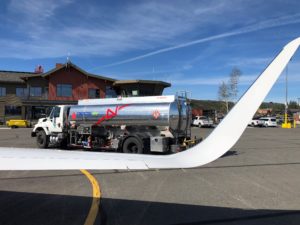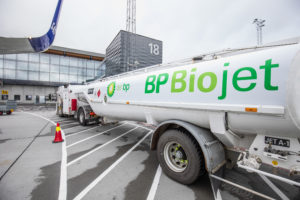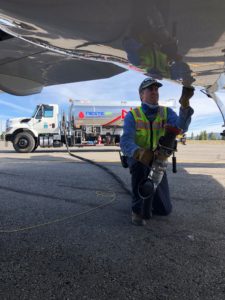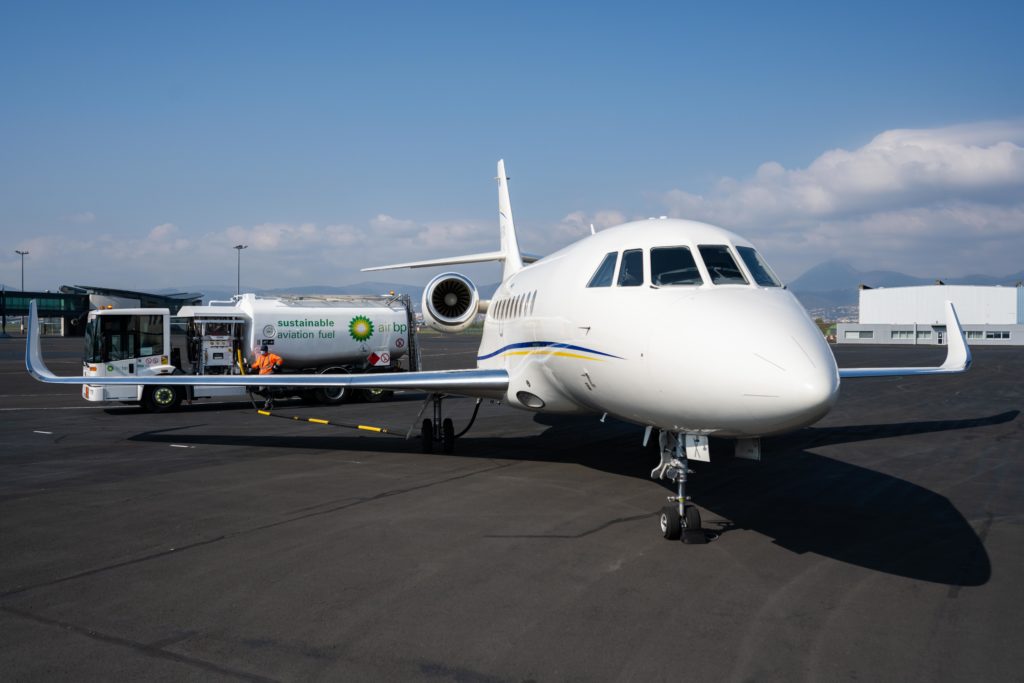Sustainable aviation fuel is very similar in its chemistry to traditional fossil jet fuel, but is produced from sustainable feedstocks such as cooking oil.
“It’s the most effective way to reduce a flight’s carbon footprint, providing one more way to reach a business’ or airport’s sustainability goals, and earn good will amongst stakeholders and communities,” says Keith Sawyer, Avfuel’s manager of alternative fuels.
A truckload of around 8,000 gallons of Neste MY Sustainable Aviation Fuel (SAF) from Avfuel provides a 22 metric ton reduction in carbon emissions over its lifecycle compared to traditional petroleum-based jet fuel.
“That’s equivalent to the amount of carbon sequestered by 28.7 acres of US forest per year. In the future, SAF could deliver up to 80% less greenhouse gas emissions over its life cycle versus traditional jet fuel if used in its neat form. It is safe, it is effective and its reach is growing on a daily basis,” says Sawyer.
“The SAF that Air bp supplies provides a lifecycle carbon reduction of around 80% compared to the traditional jet fuel it replaces, depending on which sustainable feedstock is used, the production method and the supply chain,” says Andreea Moyes, global aviation sustainability director, Air bp. “SAF will play a really important role in meeting the aviation industry’s carbon reduction targets.”
Although business and general aviation only contribute 2% of aviation’s global emissions and aviation overall contributes just 2% of emissions globally, the business aviation community has long been committed to reducing the impact of its operations. The sector believes SAF is a crucial tool for further reducing its carbon footprint.
However, there are still barriers to the adoption of SAF on a larger scale. The most notable of these is availability as demand continues to exceed the production and supply of blended SAF. Between the USA and Europe, there are only three companies that are capable of producing SAF on a commercial scale.
“The limited supply is keeping prices at a premium, which is a significant hurdle to the widespread adoption of SAF,” says Sawyer. “As more product becomes available in addition to government incentives, we expect the price of SAF to fall, further encouraging supply and demand.”
“At the moment, production of SAF is limited because of its higher cost compared to jet fuel, which is preventing wider uptake,” agrees Moyes. “A reduction in cost is the key to greater use of SAF.
“Air bp is working with customers to create more demand in the short term which will lead to more production and hopefully lower costs in the future.”
Despite this, companies are seeing an increase in demand from customers for SAF to be made available. “We are seeing increased demand from private and business aviation, as well as commercial aviation. To date, Air bp has supplied SAF to customers at over 20 locations across three continents,” says Moyes.
Most recently the company marked its first sale of SAF at Munich Airport in Germany, the first ongoing supply in France at Clermont Ferrand, and supply commitments at three locations in the UK at London Biggin Hill, Centreline FBO in Bristol and Airbus-owned Hawarden, in Flintshire.
Avfuel has also seen increasing interest in SAF from FBOs, airports, aircraft OEMs and corporate flight departments. “Companies or owners are looking for ways to fulfil their corporate social responsibility goals,” says Sawyer.
FBO users

Clay Lacy Aviation has started offering sustainable aviation fuel at the company’s two FBOs at Van Nuys Airport and John Wayne Orange County Airport.
“We just want to do the right thing by the industry, by the community, and by the planet,” says Steven Lee, vice president FBO at Clay Lacy. “We like to be at the forefront of industry changes and I think SAF is going to be a big push moving forward.”
“Customer demand along with our desire as an organization to reduce our carbon footprint encouraged us to start supplying SAF,” says Steve Maloney, executive vice president of finance and business operations from aircraft charter and management company Sun Air Jets. “We have many people asking how they can reduce their own carbon footprint, and this is an easy option.
“After a slow start and an extensive education process things are really picking up. Education has really been key. We have learned through this process that most people are not familiar with SAF or how it works.
“Pilots needed to have their questions answered and understand all the ramifications of using SAF before saying yes as well.
“They want to know what it is made of, the specication for it, and what the manufacturer of the aircraft and the engines has to say about it.
“As we’ve developed more information for pilots, sales have taken off.”
Lee agrees that education is key to encouraging more clients to switch to SAF. “We’re trying to educate our customers about SAF. I think everyone knew it was coming, but no one really knew what it was,” he says.
“The only constraint now is supply, and as more supply comes online, you’ll see more and more aircraft owners directing their pilots to use SAF. The price will also come down as a result of more supply, making the decision even easier,” adds Maloney.
Accountability

A fuel must provide a meaningful reduction in carbon dioxide (CO₂) emissions across its lifecycle to be classified as SAF. This means that even when taking into consideration the emissions created in growing, transporting, harvesting, processing and refining a particular feedstock, SAF is shown to still provide significant reductions in overall CO₂ lifecycle emissions compared to conventional fuels. This is determined using an approved life-cycle analysis method.
“Aviation does not refer to these fuels as biofuels because the term is not broad enough to cover all potential SAF feedstocks and doesn’t specify the sustainable aspect of the fuel,” explains Sawyer.
“Some biofuels could be produced from non-sustainable feedstocks that cause additional environmental damage. These cannot be considered SAF.”
“In terms of sustainable feedstock, a broad range of criteria must be met, for example minimal impact on food production, appropriate use of land, water and maintaining biodiversity. Options include some vegetable oils, municipal waste, specific strains of algae, sugar and even carbon dioxide from steel mills. The carbon dioxide balance is also considered as energy is required to manufacture SAF and this can reduce the overall benefit,” adds Moyes.
Any alternative fuel wishing to be considered as a feedstock must go through the ASTM D4054 evaluation process. Then, all concentrated SAF must be blended with petroleum-based jet fuel, meet ASTM D7566 standards (specification for Aviation Turbine Fuel Containing Synthesized Hydrocarbons) and then be recertified as ASTM D1655 (jet fuel).
“Any fuel certified to be ASTM D1655 can be used as a drop-in fuel and mixed with petroleum-based jet fuel. The feedstock used to create SAF meeting ASTM D7566 standards and the ratio at which it is blended with petroleum-based jet fuel to meet ASTM D1655 standards for jet fuel will determine the amount of carbon a fuel emits,” explains Sawyer. “Apart from the fuel’s quality certification by ASTM, the International Civil Aviation Organization’s Carbon Offsetting and Reduction Scheme for International Aviation provides standardized sustainability criteria and carbon intensity scores for the various feedstocks and processes/technologies used for producing SAF.”
To ensure the SAF is sustainable, one of two certification systems can be used: the International Sustainability and Carbon Certification (ISCC) and the Roundtable on Sustainable Biomaterials (RSB) Standard.
“Ultimately, the carbon emissions reductions of a particular supply of SAF will depend on the initial feedstock and the amount of petroleum-based jet fuel with which the neat product is blended,” says Sawyer.
“In its neat form, Neste MY SAF could deliver up to an 80% reduction in greenhouse gas emissions compared to petroleum-based jet fuel across its lifecycle. But to conform to SAF standards, the neat product must be blended with petroleum-based jet fuel with a maximum blend ratio of 30-50% neat SAF depending on the feedstock.”
“Emissions arising from every step in the lifecycle of SAF – from production, collection, transport and conversion of the feedstock plus blending, transport and combustion of the SAF, must be calculated and audited by an independent third party,” says Moyes.
In addition to calculating the lifecycle emissions, certification bodies require other specific sustainability criteria to be met, such as the protection of land with high biodiversity or high carbon value stock, responsible protection of soil, water and air, safe working conditions, compliance with human, labour and land rights, and compliance with laws and international treaties.
“It is the responsibility of the fuel suppliers to be transparent about the emissions reductions that their proprietary blends of SAF produce for their customers,” adds Sawyer.
Transparency

In April the Council on Sustainable Aviation Fuels Accountability (CoSAFA) was established. The oganization aims to accelerate the industry’s movement toward further decarbonizing aviation and increase the adoption of sustainable aviation fuel.
“CoSAFA’s mission is to work through an orderly, global approach toward providing the necessary transparency for multi-party SAF transactions,” says Tim Obitts, CoSAFA board chair and president and CEO of the National Air Transportation Association.
“CoSAFA standards will ensure transactional transparency, preventing double-counting of emissions savings and other potential accounting questions that could undermine market confidence and investments in the environmental benefits of SAF production and use.
“Recognizing that many in the aviation sector are eager to incorporate SAF into their operations, the organizing bodies of CoSAFA identified the need for a system to efficiently match SAF supplies with demand, track chain of custody and use with transparency, and ensure consistency with environmental and sustainability criteria.”
Increased use
Airlines have traditionally used the bulk of the industry’s SAF supply. However, there has been a significant rise in the use of SAF throughout business aviation over the last two years.
“There has been an opportunity during the Covid-19 pandemic for our business aviation partners to learn about and adopt sustainable fuel. We expect supply of SAF to continue to increase to meet the demands of all of our customers, including both business and commercial / cargo aviation,” says Sawyer.
In fact, during 2021 Air bp estimates over 100,000 tonnes of SAF could be produced globally, which is a sign of good progress. “But it comes from only two commercial-scale producers today. In the next few years, we should see additional suppliers come online,” says Moyes.
According to analysis by the Air Transport Action Group (ATAG) published in its Waypoint 2050 report, it is likely that aviation will use around 450-500 million tonnes of SAF a year by 2050.
“SAF is the future of aviation fuels, but we can expect to continue to see a variety of fuels in the pipeline. Beyond petroleum-based jet fuel, avgas continues to remain an important component of aviation’s infrastructure, and the industry is working on no-lead avgas solutions.
“We can expect other technologies for zero-emission aircraft — including electric, electric hybrids and hydrogen — to come online sometime around or after 2030, providing further alternatives to petroleum-based fuel, especially in short- or medium-haul flight segments,” says Sawyer.
“We see SAF as less of a bridging technology and more of a pillar for reaching the industry’s carbon emissions reductions goals.
“The introduction of SAF into the marketplace is a tremendous accomplishment and I cannot overstate its importance for the industry’s climate change commitments,” says Sawyer.
“SAF will play an important role as the industry recovers from the Covid-19 pandemic. It is our expectation that demand for SAF will grow significantly,” adds Moyes.
Obitts agrees, “In the future, once production of SAF increases, there will be widespread usage. The demand and commitment to use SAF is there, we just need the production to match the demand.”
“The continuous innovation of the industry and efforts of groups like CoSAFA, along with incentives such as the performance-based tax credit provided in the Sustainable Skies Act will help to more quickly create the supply of SAF that the business aviation industry is demanding.”





